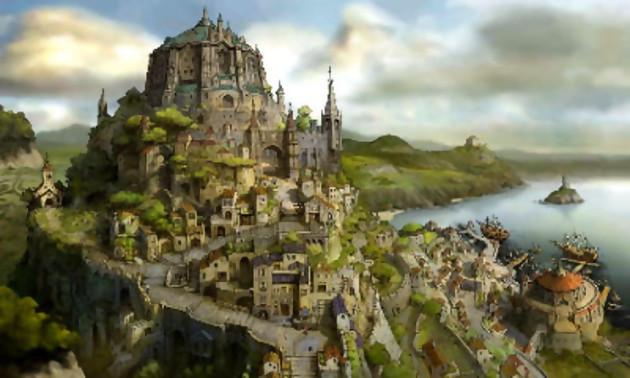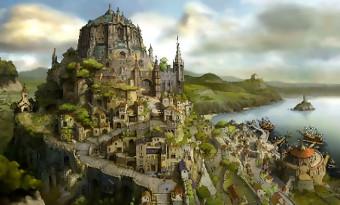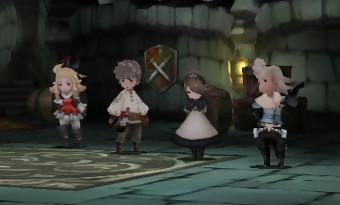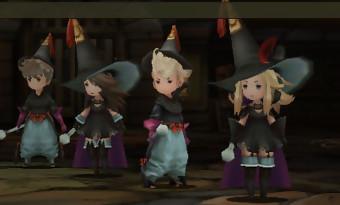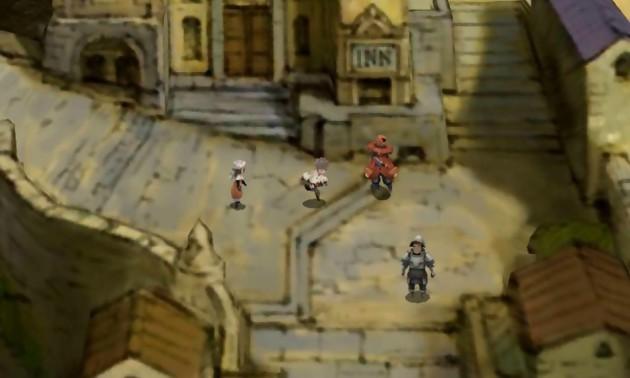 There was a time when the J-RPG (Japanese role-playing game, we give you the translation since we are nice) was one of the driving forces of video games, a kind of breath of fresh air, exoticism and innovation. who also largely participated in the discovery of Japanese culture by the Western public. Hard to say that hasn't changed. The genre is clearly losing momentum and regularly goes astray trying to renew itself, despite some nice surprises. It is therefore not surprising to see Square Enix attempt a return to basics with Bravely Default, entrusted to the hands of the developers of Silicon Studio, already authors of 3D Dot Game Heroes. The title, which our eager little hands have been waiting for since its release in Japan in October 2012, isn't just an homage to '90s J-RPGs. It's clearly a member of the family.
There was a time when the J-RPG (Japanese role-playing game, we give you the translation since we are nice) was one of the driving forces of video games, a kind of breath of fresh air, exoticism and innovation. who also largely participated in the discovery of Japanese culture by the Western public. Hard to say that hasn't changed. The genre is clearly losing momentum and regularly goes astray trying to renew itself, despite some nice surprises. It is therefore not surprising to see Square Enix attempt a return to basics with Bravely Default, entrusted to the hands of the developers of Silicon Studio, already authors of 3D Dot Game Heroes. The title, which our eager little hands have been waiting for since its release in Japan in October 2012, isn't just an homage to '90s J-RPGs. It's clearly a member of the family.
"It's the story of a virgin who goes on an adventure"
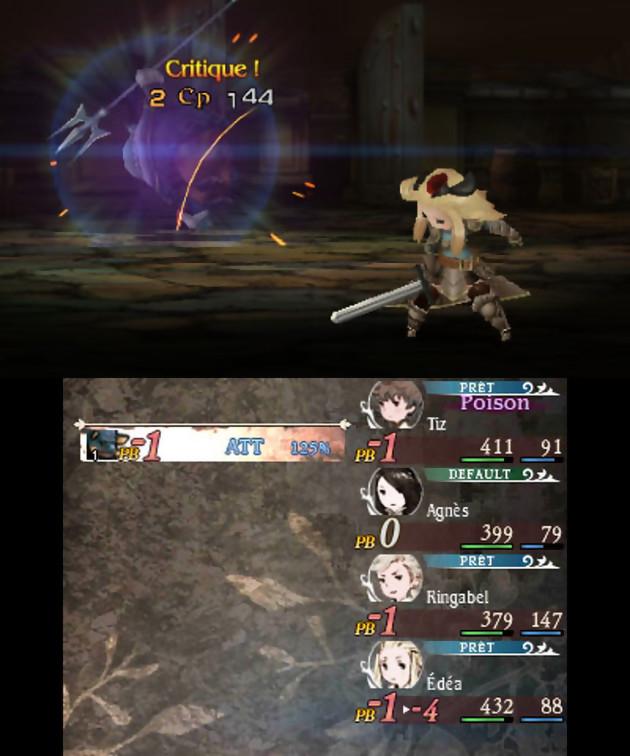 The world of Luxendarc has always lived in harmony thanks to the four crystals of life, huge gems that bring balance to the world. Their existence has given rise to a cult, Crystalline Orthodoxy, whose main representatives, the Vestal Virgins, devote their lives to blessing crystals with prayers. Enough to make Darwin sulk. Anyway, there is still a problem in this well-oiled mechanism, those who do not agree to believe. The doctrine of anti-crystallism, disseminated by the fairly recent duchy of Eternia, seeks to discredit the role of crystals and the Vestal Virgins and even to capture the latter. Our story begins as mysterious darkness attacks the crystals, disrupting the workings of the world at the same time. Yes, a bit like global warming. These are the events that will bring together Tiz, a teenager whose village has been engulfed in a fault, Agnès, the Vestal Virgin of the Wind, Edea, princess of the Duchy of Eternia and Ringabel, an inveterate flirty who has lost his memory but who has also won a mysterious diary predicting the future.
The world of Luxendarc has always lived in harmony thanks to the four crystals of life, huge gems that bring balance to the world. Their existence has given rise to a cult, Crystalline Orthodoxy, whose main representatives, the Vestal Virgins, devote their lives to blessing crystals with prayers. Enough to make Darwin sulk. Anyway, there is still a problem in this well-oiled mechanism, those who do not agree to believe. The doctrine of anti-crystallism, disseminated by the fairly recent duchy of Eternia, seeks to discredit the role of crystals and the Vestal Virgins and even to capture the latter. Our story begins as mysterious darkness attacks the crystals, disrupting the workings of the world at the same time. Yes, a bit like global warming. These are the events that will bring together Tiz, a teenager whose village has been engulfed in a fault, Agnès, the Vestal Virgin of the Wind, Edea, princess of the Duchy of Eternia and Ringabel, an inveterate flirty who has lost his memory but who has also won a mysterious diary predicting the future.
PLAY WITH EYES CLOSED
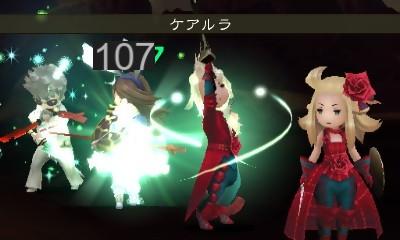 It's all there: the heroes under 20, the adventure that falls on the corner of their noses without them frankly looking for shit, the world on the verge of destruction by unknown occult forces, the journey of initiation, friendship, political conspiracies, naivety, etc. No doubt we are in a very old-school J-RPG clearly claimed as such. Which doesn't necessarily mean you're bored. The story takes a while to take, but we end up hanging on, even if we obviously have to deal with some inevitable clichés, whether in the stereotypes of the characters or in the course of events. Our European version also benefits from very good localization/translation and offers the excellent Japanese OV or quality English dubs. What to let yourself be carried away, especially since the soundtrack is also very high-end, probably one of the best of the 3DS, all genres combined. Magnificent melodies, which remain in your head even if you take the cabbage, rock a little more punchy for the fights, and some jazzy pieces of surprising efficiency: enough to live up to the glorious ancestors.
It's all there: the heroes under 20, the adventure that falls on the corner of their noses without them frankly looking for shit, the world on the verge of destruction by unknown occult forces, the journey of initiation, friendship, political conspiracies, naivety, etc. No doubt we are in a very old-school J-RPG clearly claimed as such. Which doesn't necessarily mean you're bored. The story takes a while to take, but we end up hanging on, even if we obviously have to deal with some inevitable clichés, whether in the stereotypes of the characters or in the course of events. Our European version also benefits from very good localization/translation and offers the excellent Japanese OV or quality English dubs. What to let yourself be carried away, especially since the soundtrack is also very high-end, probably one of the best of the 3DS, all genres combined. Magnificent melodies, which remain in your head even if you take the cabbage, rock a little more punchy for the fights, and some jazzy pieces of surprising efficiency: enough to live up to the glorious ancestors.
Bravely Default is technically flawless: no jerks or slowdowns of any kind, even with a dozen characters on screen
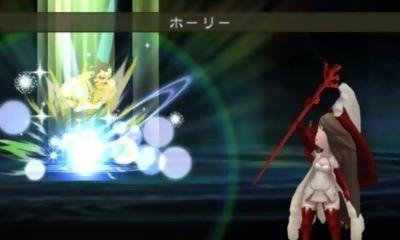 The realization takes the risk, for its part, of displeasing some. Bravely Default indeed offers a mix between 2D and 3D, as did the first Final Fantasy on PlayStation, but with a very particular orientation. The title juggles between SD-inspired characters all in polygons, classic 3D environments and those on which superb watercolor-like artwork has been applied. The result is quite special, and sometimes gives a wallpaper side to certain environments, but we must admit that this style offers a real identity to the game (at the same time as it brings it closer to the first FF). Unfortunately, the cities, which really benefit from this exceptional artistic direction, are sorely lacking in life and the dungeons, like the world map, are a bit dull... However, Bravely Default is technically flawless: no jerks, no slowdowns. of any kind, even with a dozen characters on screen. The attacks have just the right amount of spectacularity, the camera isn't fancy: we're efficient.
The realization takes the risk, for its part, of displeasing some. Bravely Default indeed offers a mix between 2D and 3D, as did the first Final Fantasy on PlayStation, but with a very particular orientation. The title juggles between SD-inspired characters all in polygons, classic 3D environments and those on which superb watercolor-like artwork has been applied. The result is quite special, and sometimes gives a wallpaper side to certain environments, but we must admit that this style offers a real identity to the game (at the same time as it brings it closer to the first FF). Unfortunately, the cities, which really benefit from this exceptional artistic direction, are sorely lacking in life and the dungeons, like the world map, are a bit dull... However, Bravely Default is technically flawless: no jerks, no slowdowns. of any kind, even with a dozen characters on screen. The attacks have just the right amount of spectacularity, the camera isn't fancy: we're efficient.
clasterisk
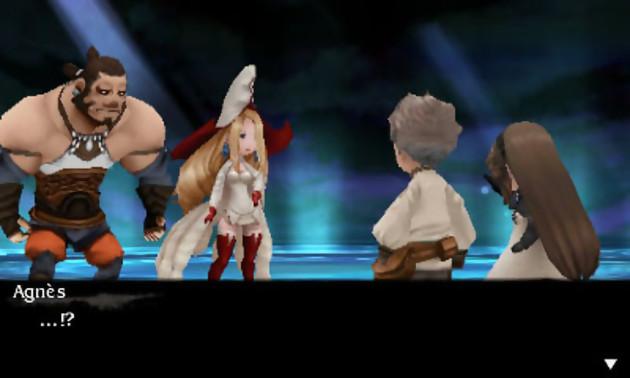 We can also say the same thing about the class system, an old spring of the genre, but which has the merit of having here a rather rare flexibility and a rather particular mode of acquisition: you will have to beat bosses, especially in side quests, to grab the asterisk allowing you to take their job. It immediately makes these secondary quests a little less secondary if you want to go far in the adventure. Too bad they don't tangle more than that, they remain fairly logically included in the course of the adventure. Your four characters can adopt each of the classes available in the game and can change them at any time, for a simple reason: with each confrontation, your fighters gain XP to increase their general level and skill points to raise the level specific to the chosen job, and thus unlock new abilities. Which can also be used by any member of your quartet, allowing the creation of a number of combinations of hybrid profiles.
We can also say the same thing about the class system, an old spring of the genre, but which has the merit of having here a rather rare flexibility and a rather particular mode of acquisition: you will have to beat bosses, especially in side quests, to grab the asterisk allowing you to take their job. It immediately makes these secondary quests a little less secondary if you want to go far in the adventure. Too bad they don't tangle more than that, they remain fairly logically included in the course of the adventure. Your four characters can adopt each of the classes available in the game and can change them at any time, for a simple reason: with each confrontation, your fighters gain XP to increase their general level and skill points to raise the level specific to the chosen job, and thus unlock new abilities. Which can also be used by any member of your quartet, allowing the creation of a number of combinations of hybrid profiles.
"ON THE TEQUENICAL AND TACTICAL LEVEL"
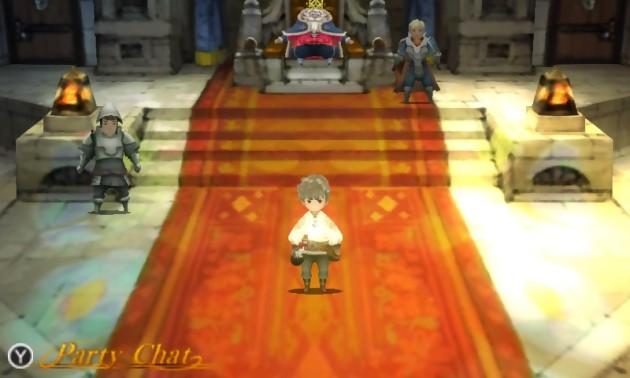 Where Bravely Default chooses to go (a little) off the beaten track, however, is in its gameplay. Attention, nothing radical, do not panic! We remain in turn-based combat: we launch physical and magical attacks, we use objects, etc. With some exceptions. The most important is the system of Brave and Default which gives its name to the game. On each turn, your characters earn an action point (Brave Points, PB), which allows them to launch an attack, a spell or other. However, with the Default action, you can ask them to take a defensive attitude and save their BP for the next turn, and thus gain up to three additional Brave Points. Thanks to the Brave function, you can then trigger these four actions in a single game turn, or spread them over several turns. But there is better, since you can get a head start on the PBs of the next turns: from the moment your PBs are positive or zero, you can choose to trigger four actions in a row... but then you will have to keep your arms up crossed for three rounds!
Where Bravely Default chooses to go (a little) off the beaten track, however, is in its gameplay. Attention, nothing radical, do not panic! We remain in turn-based combat: we launch physical and magical attacks, we use objects, etc. With some exceptions. The most important is the system of Brave and Default which gives its name to the game. On each turn, your characters earn an action point (Brave Points, PB), which allows them to launch an attack, a spell or other. However, with the Default action, you can ask them to take a defensive attitude and save their BP for the next turn, and thus gain up to three additional Brave Points. Thanks to the Brave function, you can then trigger these four actions in a single game turn, or spread them over several turns. But there is better, since you can get a head start on the PBs of the next turns: from the moment your PBs are positive or zero, you can choose to trigger four actions in a row... but then you will have to keep your arms up crossed for three rounds!
Wanting to chain attacks too quickly against an opponent who is too powerful is the best way to go straight to the grave
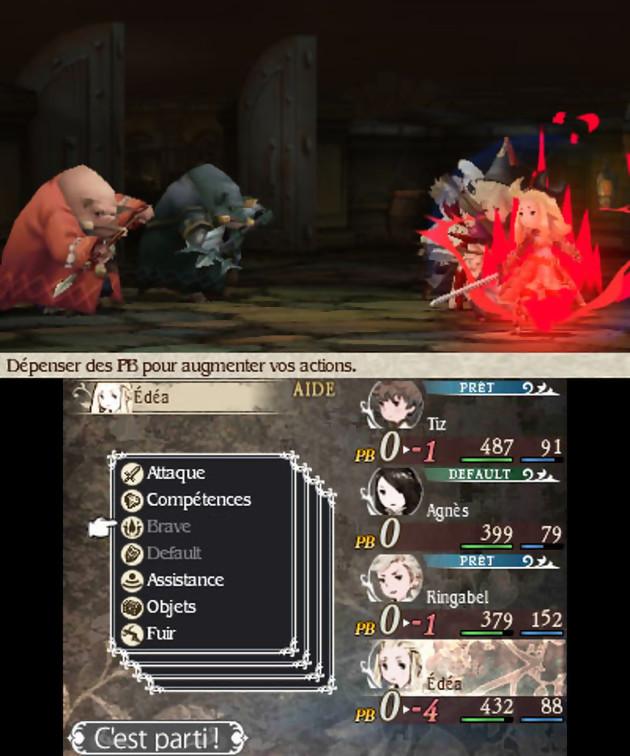 This system, also accessible to enemies, then gives an extremely important tactical dimension to the clashes. It is up to the one who will play the fairest and who will make the most relevant choices. You will need to know your opponent's weaknesses and HP at your fingertips to decide what to do (Scan magic is finally really useful): wanting to chain attacks too quickly against an opponent who is too powerful is the best way to make a straight in the grave. You also risk paying dearly for a slightly too lax end of the fight. The general level of the monsters is also quite high and the evolution of the difficulty will often require a little farming to overcome certain fights which can otherwise be very frustrating. Fortunately or not, depending on whether you are a purist or a beginner, this European version includes adjustment of the difficulty during the game as well as the frequency of random battles. Handy when you want to avoid useless games or when you're in a hurry, but it's also a big hit in the challenge level game lanterns.
This system, also accessible to enemies, then gives an extremely important tactical dimension to the clashes. It is up to the one who will play the fairest and who will make the most relevant choices. You will need to know your opponent's weaknesses and HP at your fingertips to decide what to do (Scan magic is finally really useful): wanting to chain attacks too quickly against an opponent who is too powerful is the best way to make a straight in the grave. You also risk paying dearly for a slightly too lax end of the fight. The general level of the monsters is also quite high and the evolution of the difficulty will often require a little farming to overcome certain fights which can otherwise be very frustrating. Fortunately or not, depending on whether you are a purist or a beginner, this European version includes adjustment of the difficulty during the game as well as the frequency of random battles. Handy when you want to avoid useless games or when you're in a hurry, but it's also a big hit in the challenge level game lanterns.
YOU'LL NEVER WALK ALONE
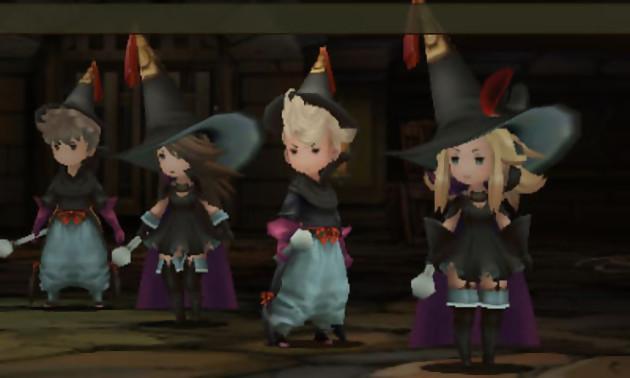 Come on, but let's not go into generality too much, Bravely Default innovates well on another point, its conception of multiplayer in an RPG, or at least the participation of other players. Because it would be difficult to really talk about multiplayer mode. Your friends registered in the console, as well as guests crossed via the StreetPass or "rounded up" by the Adventurer can indeed have an impact on your game. First of all, they can send you an action (attack, healing, potion), which can be used in combat at any time; an option that can save you the day if you have high level friends. Plus, the Mentoring system lets you borrow skills from your more advanced friends (if you don't have one, the game makes one for you). What really change the course of your game. Finally, all these little people will come to repopulate the new Norende, the village of Niz, whose reconstruction you will manage: the more people there are, the faster it will be and you will have access to more and more objects and upgrades. interesting by talking to the Adventurer. Note that if the initial idea is appreciable, the reconstruction does not last long if you have a large contact book and at the same time unbalances the curve of difficulty of the game by giving you access to items with ultra-powerful.
Come on, but let's not go into generality too much, Bravely Default innovates well on another point, its conception of multiplayer in an RPG, or at least the participation of other players. Because it would be difficult to really talk about multiplayer mode. Your friends registered in the console, as well as guests crossed via the StreetPass or "rounded up" by the Adventurer can indeed have an impact on your game. First of all, they can send you an action (attack, healing, potion), which can be used in combat at any time; an option that can save you the day if you have high level friends. Plus, the Mentoring system lets you borrow skills from your more advanced friends (if you don't have one, the game makes one for you). What really change the course of your game. Finally, all these little people will come to repopulate the new Norende, the village of Niz, whose reconstruction you will manage: the more people there are, the faster it will be and you will have access to more and more objects and upgrades. interesting by talking to the Adventurer. Note that if the initial idea is appreciable, the reconstruction does not last long if you have a large contact book and at the same time unbalances the curve of difficulty of the game by giving you access to items with ultra-powerful.
